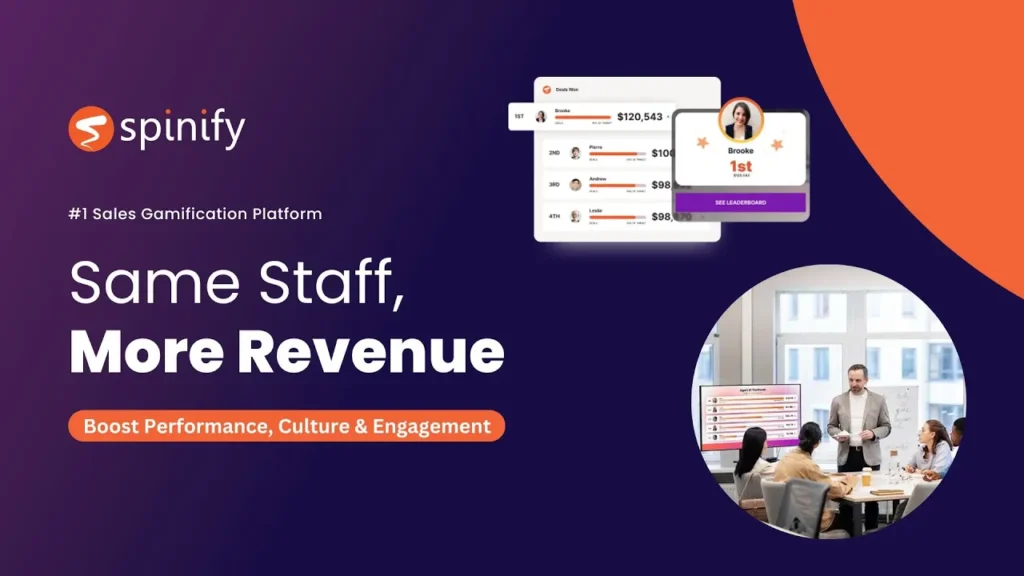What is sales enablement?
Sales enablement is a “strategic, cross-functional discipline designed to increase sales results and productivity by providing integrated content, training and coaching services for salespeople and front-line sales managers along the entire customer’s buying journey, powered by technology.” – CSO Insights.
An effective sales enablement strategy provides comprehensive support through a blend of the right tools, content, processes, and training. It’s designed to empower sales teams to sell smarter and more efficiently, thereby driving sales performance and contributing to the overall success of the organization.
By adopting a holistic and integrated approach to sales enablement, businesses can ensure that their sales teams are well-prepared to meet the challenges of the modern sales landscape, ultimately leading to improved sales outcomes and sustained business growth.
What is the goal of sales enablement software?
The goal with a sales enablement program is to enable salespeople to do their jobs to the best of their ability and help an organization benefit the most.
Sales process can be streamlined and boosted to promote effective sales and revenue growth.
There isn’t one single best sales operations and practice for a sales force to perform; it takes multiple practices to help a sales rep perform their job, and relies on a business’ marketing team too.
With that being said, here are the eight best sales enablement practices!
1. Identify the high-performing activities
There are two steps to this practice. The first is identifying the highest-performing salespeople in your company’s team – the sales leaders – and understanding what they do that makes them so successful.
This deep dive into sales enablement strategies used by top performers is crucial.
Once you’ve identified their activities, then you can ‘institutionalize’ them for the rest of your sales team. Institutionalizing these practices means making them understandable and accessible as sales performance enablement content for the rest of your sales team.
Robust sales enablement software can facilitate this by providing analytics and tracking tools to help identify and highlight those top-performing activities.
Investing in sales training that specifically focuses on replicating these winning strategies is also key.
This means that your whole sales team can leverage these proven sales enablement tactics at relevant points in the sales cycle, boosting their sales performance as well as company revenue.
Here’s how an effective sales enablement software can empower sales leaders throughout this process to support their sales teams:
Data Tracking and Analysis
Advanced sales enablement software allows sales leaders to track key performance metrics, providing a clear picture of which sales activities are driving the most success.
Best Practice Sharing
Sales enablement software can create a centralized repository for top-performing sales materials, strategies, and techniques. This facilitates easy sharing and replication, fostering stronger sales teams overall.
2. Provide access to content
The American Marketing Association states that 90% of content is unused by sales teams. The biggest cause of this is that sales reps are just unable to find the content.
Sales enablement software should be:
Flexible – the sales content that is recommended should be based on performance, and sales event triggers should be controlled by your marketing automation platform.
Sales conversations can then be aligned with the various stages in the buyer journey.
Integrated – the software should connect seamlessly with other tools (including some used in the sales and marketing team department to ensure alignment) in order to keep the sales process streamlined and automated.
Organized –all tools for content and sales should be easy to find and use in this repository.
This is one of the best practices for sales enablement, because your salespeople are doing the best that they can, but they can’t be expected to do their job unless you help them by not only giving them the right tools, and the content that they need, but making sure that they can access them easily.
Beyond this, the content must be constantly updated so that none of your sales reps are ever behind or accidentally make a mistake when interacting with potential buyers.
3. Start small and grow gradually
You can’t really expect huge changes overnight. Start with realistic expectations and small changes so that your reps can adjust well and your customers also don’t notice a sudden change.
Sales enablement isn’t about just the face-to-face customer interactions that your sales reps have with buyers but can extend to blogs, informational videos and more passively-consumed content such as these.
Taking the time to grow also means sticking to such content and not feeling demotivated when they don’t receive ridiculous amounts of attention.
Starting small and growing gradually applies to many things –content for salespeople, content for customers, growth of the company, growth of the marketing and sales team itself, growth of your customer base.
They have to happen at a healthy rate, otherwise they could get out of hand very quickly and actually have a detrimental effect on your company.
Implementing sales enablement best practices should facilitate natural growth that your sales success comes from doing what’s best for your salespeople, your customers, and your organization – that’s the healthy way to help sales.
4. Choose a launch opportunity
You probably already know that there’s little as exciting (or stressful!) than a launch. Whether it’s a new product or service, choosing a launch opportunity is one of the biggest parts of the sales enablement process.
Sometimes the entire success or failure of a product or service is in how well it was launched, so the right launch really is key and in order to do it right, it needs to be data-driven so sales enablement can succed.
Leading up to a launch, you should do a few things:
With a small group of users, share updates on the good/service early and often.
This will help provide you with invaluable feedback on how it can be improved and how it’s performing.
Feedback on the user interface, bugs, content, and marketing can help shape the product into the best form of itself.
Focus on what could be wrong with the product rather than what’s right; this mindset will help fix even little problems that may occur and uncover biases in test groups rather than cover them up.
Mentors, guides, supporters and finance partners should be involved as well.
After you’ve done these things, picking an actual launch opportunity depends on your organization.
The perfect day is up to you. You can pay attention to sales cycles, the seasons, weather, economic trends, sales and marketing trends, and even public holidays – but whenever your launch, pick it, and stick to it.
Your marketing team should be on top of things for launch day.
Get everything ready for the launch (marketing content like graphics, infographics, designs, emails, copy, etc.), and then let the public have at it!
5. Align your sales approach with the customer path
Customers’ paths vary depending on what they’re buying and their profile.
In general, your sales team needs to capture and keep customers’ attention and convince them of the value of the product/service, just like anyone in sales would need to.
However, that doesn’t cover the whole customer path and buyer journey, and your specific company and sales strategy needs to find out what your customers’ path is like.
This can be done by doing the following:
Creating your buyer persona. Understand who your customers are.
There isn’t just one buyer persona – there’s a big difference in the buyer journey for someone who’s been researching for months and someone who’s just started looking for a product/service.
Understanding what the goals of your buyers are: research, finding the right price, wanting more information.
Mapping touchpoints – these are times when customers come into contact with your company in any way. Ads, marketing, phone calls, experiences, etc.
Identifying pain points – what are the ways in which your customers face difficulties and where do they occur in the customer journey’s path?
Which members of your team can best handle these, and what changes can you make to reduce or remove them?
Once you’ve done this, you will find that your sales approach is far more aligned to your customers’ path and you’ll end up with a lot more successful sales.
This is one of sales enablement best practices because it smoothens out what can sometimes be a bumpy road for buyers.
6. Understand your sales team
Your sales reps shouldn’t be forced to follow rigid scripts or do their job in only one set way. While new sales enablement technology and processes are there to support them, the goal is to enhance their work, not stifle it.
You shouldn’t focus too much on process automation and strict scripts; rather, approach the entire process of sales enablement with an inclusive attitude and an open mind.
All of your salespeople are different and, even within their role, they perform tasks with their own unique approaches.
Understanding the nuances of their jobs can help you provide the sales enablement strategies and tools that will empower them to do even better.
Schedule regular meetings with them to measure how well they’re doing, what their experiences are, and how they feel you can help them.
This open communication offers several key sales enablement benefits:
Identifying Pain Points: Are there specific challenges they face throughout the sales cycle? Sales enablement software and resources can be tailored to address these bottlenecks.
Resource Optimization: Learn which sales enablement tools and content are most helpful for your reps. This allows you to refine your investment for maximum impact.
Building Trust: An open-door policy fosters trust and collaboration. Sales reps feel more comfortable asking for additional sales enablement support when needed.
Remember, sales enablement is about empowering your sales team, not micromanaging them.
By understanding their strengths, challenges, and preferred work styles, you create a dynamic sales environment where everyone can thrive.
7. Use available technology
Technology and team alignment are 2 important sales enablement best practices. Useful sales enablement technology can be anything from software that helps inform your buyer personas to forecasting.
Using the right technology goes far; a study by CSO Insights said that 60% of sales organizations have a longer sales cycle because they don’t use proper sales enablement tools.
Using a technology stack that’s right for your business and your sales enablement process can help you boost sales efforts.
They can help in so many stages and facets of sales cycles, like goal-setting, forecasting, training, tracking revenue, and more.
Spinify is an example of this; we’ll talk more about this later!

Align Your Sales and Marketing Teams
Additionally, you can achieve sales enablement team and marketing alignment if you employ the same technology for your marketing and sales teams.
Effective sales enablement means also including your marketing team in the loop because marketing is what can capture customers’ attention in the first place.
8. Continue to train and upskill your sales teams
Growing means never stagnating, and a business is no different. Your team, like your company, needs continuous training and upskilling.
There will always be new technology, information, and materials for your sales reps to absorb and make use of.
The best of sales enablement strategies and programs are ones that help your sales team learn and keep skills; it isn’t easy to keep new skills, so keeping your sales and marketing teams on their feet and supplying them with continuous training and refreshers will help them hone their skills and keep your company growing!
Training can cover content, skills, tools, workflows, and more so that your reps are aligned and unified when they interact with customers.
You can employ a variety of sales enablement methods to keep your team engaged, such as roleplays, meetings where you ensure that they feel they can speak up, team-building events, and more.
The bottom line is, prospects and customers expect a lot from their buying experience.
Aside from just a hyper-personalized interaction, sales reps need to know exactly what to say, show, and do so that every buyer feels satisfied, and marketing teams need to be on the same page as sales representatives as well.
We hope that these sales enablement best practices have helped you understand more about how you can help your sales reps do their job to the best of their abilities and how your organization can boost its revenue.
Elevate Your Sales Enablement Strategy with Gamification: Discover Spinify
Discover Spinify, one of the best sales enablement software solutions on the market, and learn how gamification can revolutionize your sales process.
In the competitive world of sales, gamification is a powerful sales enablement tool that transforms routine tasks into exciting challenges.
Spinify expertly leverages gamification within its sales enablement platform to drive motivation and engagement, giving your sales team the edge they need.
By incorporating game-like elements such as points, badges, and leaderboards, Spinify’s sales enablement software makes the often tedious aspects of sales more enjoyable and rewarding.
This translates into higher sales productivity, improved sales team morale, and valuable data insights.
Spinify seamlessly integrates into your existing sales enablement stack, providing a user-friendly and impactful way to boost performance.
Here’s how Spinify leverages gamification for a winning sales enablement strategy:
Data-Driven Insights: Spinify seamlessly integrates with your existing CRM and sales tools, pulling key performance metrics in real-time.
This data fuels the gamification engine, allowing you to create customized leaderboards, competitions, and rewards that align with your unique sales goals.
The platform’s analytics provide essential sales enablement insights, helping you identify areas where your sales team excels and where additional sales training or coaching might be needed.
Motivation and Recognition: Spinify transforms the sales experience by making it fun, competitive, and rewarding.
Sales reps earn points, badges, and rewards for achieving milestones or surpassing targets.
Leaderboards offer instant recognition and foster a healthy sense of competition, driving sales enablement by encouraging sales reps to strive for continuous improvement.
Spinify’s social features allow for sales team collaboration, peer-to-peer recognition, and a sense of camaraderie that boosts morale and keeps your sales team engaged.
Enhanced Learning and Skill Development: Gamification turns sales training and onboarding into an interactive experience.
Spinify can incorporate challenges within the sales enablement process. This makes learning more engaging and helps sales reps engage better in the sales process.
If you’d like to experience the incredible benefits of gamification in your sales department, harnessing the power of our sales enablement platform, book a free demo today.
Let Spinify show you how to make your sales process more effective and enjoyable for your marketing and sales teams!



